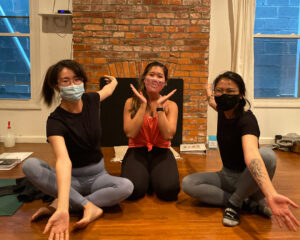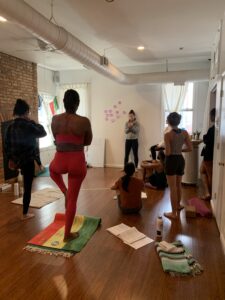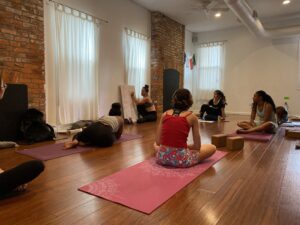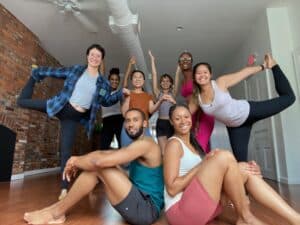In this blog post, Aaron shares his experiences being a part of a Yoga Teacher Training (YTT) community. Learn about how YTT teachers foster a sense of community during training and encourage their trainees to build communities through their own practices.
Building Community
I’ve always loved the community aspect of going to a studio and practicing yoga with people of all different backgrounds. Over the course of my 200-Hour Hybrid Yoga Teacher Training, I’ve had the privilege to experience the blossoming of that connection. It’s due to my classmates, teachers, and the way our training is structured.
Building Community Online

Our teachers led us through a series of community building exercises. Each fostered a sense of community that helped our class connect from the very beginning of the program. First we learned more about one another then we created ground rules for our training.
Fostering Familiarly and Inclusion
In the first online session, teacher Jasmine gave us the opportunity to share:
- how we’d like to be identified (an open question for people to share whatever they’d like about their identity)
- pronoun preferences
- training intentions
We also went into breakout rooms with a partner to share a fun (non-work related) fact about ourselves and if we had any injuries. Afterwards, we reconvened as a group and presented what we had learned about each other.
 Our class is very diverse with representatives of different genders, race and ethnicities, career paths, and life experiences. We worked through this exercise together learning about our shared similarities and our own uniqueness. Afterwards I began to feel like I was in a group where I belonged and was accepted for who I am.
Our class is very diverse with representatives of different genders, race and ethnicities, career paths, and life experiences. We worked through this exercise together learning about our shared similarities and our own uniqueness. Afterwards I began to feel like I was in a group where I belonged and was accepted for who I am.
My feelings of inclusion were bolstered over the course of the training in many ways. My teacher Camryn has a background in the medical field and shares my interest in yoga anatomy. She worked with me, during and after class, to answer my questions about complex anatomical topics like connective tissue and diaphragmatic breathing. And my classmates have been welcoming and supportive from day one. They help me take photos for my blog series, also work out cues and sequences. They display nonjudgement when I open up about vulnerable aspects that make up my yoga journey.
Ground Rules
In another online training session, our teacher Dr. Aparna, led us through the exercise of creating a list of ground rules. The goal was to help cultivate a mindful space with loving kindness and no judgements.

The importance of this kind of exercise became apparent to me in the first few weeks of training as I experienced firsthand how emotional YTT can be for some. During a meditation at the start of one class, out of nowhere, the emotions of losing a loved one came back to me. I felt a little embarrassed when I noticed tears in the corners of my eyes. But ultimately, I was able to feel those emotions and process them healthily in part because I felt safe in my environment. Had we not taken the time to create ground rules together then I’m not sure I would have been in a mental space to experience that moment fully.
In Person Class
With the hybrid teacher training model in addition to training online we also have the opportunity to train in person. I still remember riding my bike up 14th street with my yoga mat clipped to the bottom of my backpack for our first in-person class. It was great to see everyone in the studio after hours of training together online earlier in the week.
Community Building
Despite having only met virtually before there were a lot of hugs and happy hellos that first day. And when everyone got settled our teacher, Blythe, gave us the opportunity to continue building the community we fostered online. Sitting in a circle we shared a little more about our yoga journeys with one another. After we did our daily meditation practices, Blythe explained that before we determine what we teach, it’s important to consider how we teach. Specifically, that we teach in a way that embodies and reflects yogic ethics such as ahimsa (1). It’s a Sanskrit term that can be translated to non-harming, or alternatively, the act of actively loving. So that we co-create a space with students that’s inclusive and a relationship of equals.
We were taught several ways to accomplish this. One that especially resonated with me is having service be the foundation of my role as a teacher. Learning this has helped me shift my attention away from any teacher goals that don’t serve me (such as wanting to be the “best” teacher or insta-famous), and move my attention to one solely focused on service. This shift has already made the prospect of teaching more enjoyable for me. Also, I think it will result in more impactful classes for my future students too.
Classmate Camaraderie
During that first week of class my fellow YTT trainees and I enjoyed a sense of fellowship beyond training. Eating together outside we talked about: our backgrounds, school, work, and all the different directions we were thinking about taking our yoga teaching. Sitting in the shade, amidst the sounds of the city, I enjoyed the company of my classmates. I couldn’t help but notice how joyful it was to be connected to this community.
What’s To Come
Yoga District’s teacher training is taught by multiple teachers. Many of whom teach different styles of yoga. In the next post: I’ll share some of the styles those teachers have introduced, what it was like for me to practice it, and how it’s impacted the style of yoga I’d like to offer to a community.
Sources:
- Ahimsa, https://www.swamij.com/yoga-sutras-23545.htm#2.35



